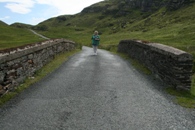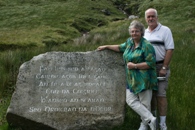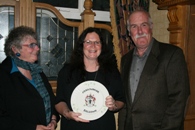The Donegal Relief Fund
Emigration to Australia – an article from the Donegal Democrat September 1991.
Emigration from Donegal to Australia in the last century and particularly large scale emigration from the west of the county was dealt with by Dr. Richard Reid, a native of Portrush, now lecturing in History at the University of Canberra, in a lecture at Glenveigh National Park at the weekend, organised by An Taisce.
Dr. Reid said that the Irish have been in Australia since the beginning of migration virtually. They are strong in most communities throughout the country. Their experience of emigrating to Australia was different to that of the people who went to North America. The main reason for that is that the emigrants to Australia were nearly all Government Assisted Emigrants. Their fare to Australia was paid for them.
The convicts going to Australia in the 1830s had a better experience than people travelling on the North Atlantic whose trip was three times shorter. The reason for the good treatment of the people going to Australia was the requirement for good healthy agricultural labourers. Each ship travelling to Australia had a surgeon on board. There was an allocation of space per berth, a diet was worked out, passengers had to wash every <j;w and gun-deck daily. clean their clothes and clean their berths. The death rate on the ships to Australia was very low in the 1820s and the 1830s while the death rate on the Atlantic in the 1820s/30s and 40s was very high.
The same care was taken of the Assisted Emigrants from the 1840s to the close of the century. Only one emigrant in ten going to Australia from Ireland in the 19th century was a convict. To obtain an Assisted Passage to Australia a person had to undergo a medical test having filled in a form, which had to be taken to a magistrate, a doctor and parish priest or Church of Ireland rector for their signature, and then sent to London. People had to report to either Plymouth or Birkenhead a week before the ship was due to sail for examination. They were told to bring certain items of clothing and a sea chest. Although the passage was assisted, people needed money as they had to buy a chest and pay for their passage to England.
CHAOTIC
Whereas travelling to North America was chaotic it was not so on the ships to Australia and even boarding cards were required much as they are on airplanes today. Efforts were made to berth people from the same parish close to each other on the ships and this would have been helpful on a voyage which lasted a few months.
There was. a surgeon on the ship responsible for health and moral welfare and where a school master corud be found he was appointed and there is evidence that there were people who began the journey illiterate and were capable of basic reading and writing by the time they landed. The teachers also catered for the children. Dr Reid said that it was the Free Emigrants who founded the Irish-Australian Society in the 19th century, not Ned Kelly. Four out of five emigrants were males and up until c. the 1850s/60s society contained many males and a considerable number did not marry. The Govememnt was worried about a balance of the sexes with the Assisted Emigrants and they attempted to obtain an equilibrium.
Because of the Gold Rush, when males paid their passage, in the early 1850s, five out of six assisted Irish emigrants arriving in Sydney were females. Care was also taken of the Irish emigrants when they arrived in Sydney. Single women were taken to a barracks in the middle of the town. People came there to hire them and they were given advice as the current rates for work. Legal binding contracts were drawn up. Offers were made, at one stage, to take people into the country, where labour was short. People came back to the Emigration Authorities if they had problems.
Dr. Reid said that the importance of this scenario is that the Irish going to Australia do not have bitter memories; they were sad, of course, but not bitter. He said that the position of the Irish in Australia is more mellow than that of the Irish in North America. Most emigrants to Australia came from Counties Clare, Tipperary and Fermanagh.
600 FROM ONE PARISH
County Donegal emigration does not really feature until c.1859. In that year it :hc until 1863 Donegal is one of the key counties for emigrants. More dramatically, 90% of the Donegal emigrants came from the north-west coast. In 1859 600 people went from Tullaghbegley parish to New South Wales. There is no other parish in the history of Assisted Migration to New South Wales with the same story.
In 1858 a group of local priests published an appeal in the Freeman's Journal in Dublin and sent it to the Irish diaspora. The appeal opened as follows:— "Countrymen, and Fellow Christians, In the wilds of Donegal, down in the bogs and glens of Gweedore and Cloughaneelly thousands upon thousands of human beings, made after the image and likeness of God, are perishing or next to perishing amid squalidness and misery, for the want of food and clothing, far away from human aid and pity.
On behalf of these famishing victims of persecution and oppression we venture to appeal to your kind sympathies and religious feelings and hope that for the sake of Him who bore our infirmities, you will share with us their distress by lending some substantial assistance to enable and starvation. The ground for this appeal is simple and may be thus told. The districts of Gweedore and Cloughaneely are the bleakest and most mountainous in Donegal or in Ireland. The entire surface is broken up by huge, abrupt and irregular hills of granite, covered by a texture of stunted heath, for the space of between is but a shaky and spongy marsh. The inhabitants of these wilds are all Celts of the pure old race with the pure old faith who cultivate small patches of arable land along the shore or cladagh by which their wretched cabins are built and subsist principally by rearing stock and grazing sheep on the steep slopes of their mountains and in their hollow glens."
The effect of this on the Celtic communities of New South Wales can be imagined as most of the members came from areas which were not as badly off. The economic background to the appeal was the alterations which the landlords, people such as Hill, Alphort and Nixon, brought to the farming system in the area. They disposed of the Rundale and introduced sheep-grazing where people had resided.
SHEEP TAX
In a townland in Gweedore in 1858 there had been a series of sheep killings and the result was that the Grand Jury in Donegal decided that people would have to pay for the dead sheep. They had stationed police in the area to collect the Sheep Tax and as a result the priests claimed that the people were driven to the verge of destitution and they therefore made their appeal. They set up the Gweedore Relief Committee and asked people to subscribe money. The priests were seeking help in kind for the people of Gweedore.
The New South Wales Irish responded in a different way. They did not see the point of sending money to Ireland as they believed it would end up in the landlord's pocket as rent and fortify the system. They felt they had to break the cycle. They collected money to help people emigrate to New South Wales as assisted emigrants. To do that they had to convince the New South Wales Government that it was worthwhile bringing out large numbers of people from Donegal. They did not find this difficult. They collected money to pay the Government parts of the Assisted Passage.
At this stage people wishing to emigrate to New South Wales did not apply to London, they relied solely on the remittance regulations. A person in the colony paid money to bring them out. The money was put down in 'New South Wales and the Government would pay the rest of the passage. A relief fund was set up in New South Wales to pay the portion of the passage which was necessary. They collected many thousands of pounds. The Donegal situation was represented in the colony. The case was put mainly by Archdeacon John McEnroe, a Catholic priest from Co. Tipperary, who became secretary and president of the Donegal Relief Committee. He was an intelligent man but given to slight excess when he got upon a stage particularly to speak to Irish people.
Nowhere in the appeal did the priests say that the people of Gweedore and Cloughaneely were evicted tenants. They said they were in a bad situation. Archdeacon McEnroe said at the first meeting in Sydney, that the people in Donegal were out on the seashore, thrown out of their humble hovels and that they were starving. Action was needed or they would die. The idea of eviction, a powerful word, meant people were willing to give large amounts of money to bring them to Australia. Little groups of the Donegal Relief Community were set up all over New South Wales.
A person was sent from Australia to select the people. It could not be left to the priests as the Government wished. (MORE WAS TO FOLLOW BUT IT NEVER MADE IT TO PRINT)
|

|
|
Rae Luckie crosses the Bridge of Tears
|
2008 - The Circle is Complete
Some 150 years later an e-mail passed from Australia to the Clan in Donegal. Rae Luckie, the great-grand daughter of one of those emigrants, Maggie/Madgy Galagher intended to retrace her ancestor's journey back to Donegal. She wished to know if it was possible to find any family connections that might be still resident in Cloughaneely, which was the only information she had. She was put in touch with Lindel Buckley (see the Donegal Resources website) and Tulloghobegley Irish was reckoned the most likely place to be Maggie's home turf.
In July 2008 Rae made the journey back to Donegal. She made her way into the Parish of Cloughaneely by way of "Droichead na nDeor" in Gaelic (the Irish language) or in English, the Bridge of Tears. It was so called because it was the custom in years gone by for the would-be emigrant to be accompanied by their friends and family along part of their journey. This was the place of parting. Many a tear fell on its parapets because generally emigration was a one-way trip, especailly if it was to places far off, such as America or Australia. Rae also cast a tear as she, the first descendant to return, as far as she knows, felt the sadness that Maggie must have felt and thought of the hard life that Maggie was to endure in Australia far from her home, family and friends.
|

|
|
Rae and husband Barry beside the commemorative stone
|
Rae and her husband Barry then continued on to Tulloghbegley Irish. While they were not able to pinpoint exactly where Maggie's home might have been, they were able to travel through the townland and know, as the breathed in the morning air and looked out on Tory Island lying out in the broad Atlantic Ocean, that after almost 150 years the circle was complete.
During their visit they also had the ooprtunity to meet up with Lindel Buckley of the Donegal Genealogu Resources website who was over from her home in New Zealand carrying out research in Donegal. On the night they met up Lindel was being presented with a Gallagher Plate by Adrian Gallagher of the Gallagher Clan as a token of appreciation for all the help Lindel had given to the Clan at its inception and continues to give to the many who are researching their Donegal roots.
A further descendant of Gallaghers who emigrated via the Donegal Relief Fund has since contacted us. They were more fortunate in that the records placed their ancestor leaving from a townland called Devlin and we on this side of the world were able to discover and make contact with people who are almost certainly relatives. Again in August 2009 this Australian made the long return journey back to the homeland of their ancestor. Not such a long journey to travel any more but it was a long journey in time passed since the emigrant departed in fear and hope..
FROM THE BRIDGE OF TEARS TO AUSTRALIA AND BACK
VISITING MY PAST by Joy McGuire see HERE
FERRY and GALLAGHER - PART OF THE DONEGAL RELIEF FUND STORY by Collen Wright
Colleen had first contacted the webmaster before her coming to the 2007 Gallagher Gathering, Unfortunately in the midst of all the preperations for that event her story was overlooked. We are glad to have rediscovered it and you can find it HERE
|

|
|
A Gallagher Plate being presented to Lindel Buckley in appreciation of all her help to the Clan.
|